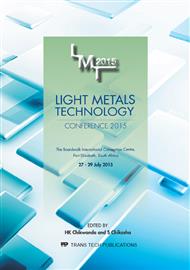p.239
p.244
p.250
p.259
p.265
p.272
p.279
p.285
p.291
Diamond Insert Wear when Turning Rapidly Solidified Aluminium RSA 443 of High-Silicon Content
Abstract:
Rapid solidification of molten metals has been recently used to generate a new group of alloys having ultra-fine microstructures and high end mechanical properties. Therefore, such alloys can be successfully used in the optics industry to produce diamond machined mirrors and mould inserts for plastic lens injection. Rapidly solidified aluminium grades characterised by their ultra-fine grains can be used to replace traditional optical aluminium such as 6061-T6 which has coarse microstructure when making optics. However, there is currently no data available on the performance of these new grades in terms of diamond tool wear when machined in single-point diamond turning operation. This paper reports on the wear mechanisms of natural diamond tools when turning RSA 443 which is a new aluminium grade produced by rapid cooling process. Although this new aluminium grade enjoys fine microstructure, it is harder than traditional optical aluminium because of its increased content of silicon (about 40%). Therefore, there is a need to establish a deeper understanding of diamond tool performance when using diamond turning of optical components from this material. In this study, three machining parameters, namely cutting speed, feed rate, and depth of cut, were varied at three levels and the edge wear of the diamond inserts was observed using scanning electron microscopy after 4 km of cutting distance. The first observations from this preliminary study show that tool wear of diamond is more sensitive to the change in cutting speed than it is for other cutting parameters. Wear is relatively high (12 µm) at the lowest cutting speed (500 rpm). However, at high cutting speed (3000 rpm) the edge wear was small (3 µm). This could be attributed to the increased impacts of cut the material on the cutting edge. The study also reports on the surface finish obtained at the different combinations of cutting parameters.
Info:
Periodical:
Pages:
265-271
Citation:
Online since:
August 2015
Authors:
Price:
Сopyright:
© 2015 Trans Tech Publications Ltd. All Rights Reserved
Share:
Citation:


